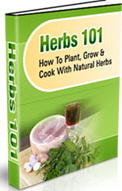Oregano
 Oregano is typically used in a variety of dished, especially in Italian cooking. This herb is easily grown at home in pots and home gardens by even average gardeners. The plant is considered part of the mint family, and originally grew wild on the hills of Greece.
Oregano is typically used in a variety of dished, especially in Italian cooking. This herb is easily grown at home in pots and home gardens by even average gardeners. The plant is considered part of the mint family, and originally grew wild on the hills of Greece.
Oregano has been used for medicinal purposes for years. Many ancient cultures used the herb for aching muscles, insect bites, and more. Oregano tea has also been used as a treatment for coughs and asthma.
Early settlers to North America introduced the herb when they arrived, and it now grows wild in many areas of the country.
Growing Oregano
Growing oregano is relatively easy for most home gardeners, given a few simple tips.
Oregano does not tolerate cold weather well. If you are sowing the seeds outside, wait until the weather is consistently above 45-50 degrees and the risks of frost are over. If you wish, you may start the seeds during the cold weather months by growing them indoors.
The soil for oregano should be well draining, and you may need to work mulch into the soil before planting. Make sure the soil is well prepared so it will not retain water. It is unnecessary to add additional fertilizer to the soil.
Harvesting Oregano
If care is taken during the growing process, care should be taken to achieve the best, most flavorful leaves. Pinching off the heads during the growing process will produce more leaves throughout the life of the plant.
Once the oregano plant has reached 5 inches, you may begin to harvest by pinching off the leaves of the plant. If you see the growth of the plant stalling, you may trim back 2 to 3 inches from the branches.
The extra leaves you do not use immediately may be either dried or frozen for later use. Like most other herbs frozen oregano may be stored up to 6 months if it is in a tightly sealed bag.
For more information and recipes click here.

